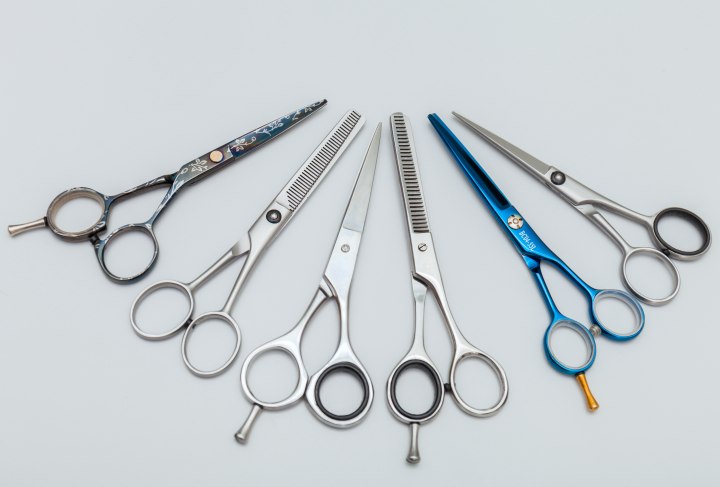Caring for Your Haircutting Shears

But what about when they're not in use? How should you take care of them to ensure you don't ruin your (often significant) investment? Here are some tips to help keep your scissors in good working order:
Most stylists instinctively know this, but I have seen cases where non-stylists (receptionists, visiting friends, kids) have grabbed the stylist's shears to give something "a quick snip." Usually, the stylist is otherwise occupied or away from their station and unaware of this occurrence, and when they do find out, sparks start to fly.
Cutting anything other than hair with your shears risks dulling or damaging them. Threads of fabric or sheets of paper have different thicknesses and textures than hair. Hair consists of long, interconnected, microscopic strands of protein. Paper is made from pulped and compressed wood fibers with binding agents and often some cotton or other plant fibers. Fabric can be made from plant fibers (or synthetic polymers spun into fibers) twisted into threads and woven into sheets of cloth. The variation in density, texture, and size may seem insignificant, but using your scissors to cut anything other than hair will dull them faster.
#2 – I will keep my scissors clean and protected.
To follow the guidelines set by the agency governing hair stylists wherever we live, we must clean our shears frequently. Often, fragments of hair are left behind in the crevices of the scissors during the cutting process, or droplets of sweat find their way onto the shears as we work. Many areas have laws requiring that scissors be cleaned and sanitized between customers.

At the end of the workday (after your last client) or if you're putting them away for more than a couple of hours, you should follow your normal cleaning and sanitizing procedure and then apply a small amount of oil by rubbing the shears with a soft cloth to which the oil has been applied. Don't apply too much oil, or else you could make them slippery to handle. Dropping the shears would be bad.
After they've been cleaned, sanitized, and protected, store your shears in a protective case with a soft, absorbent lining that will help keep the shears from moisture and environmental factors. The shears should have their own compartment in the storage case, and you should never store your shears loosely with other tools. If the shears and other tools are allowed to knock against each other, you risk damaging the blades, marring the cutting edge, or misaligning the shears. Store the case in a dry location.

One of the most heartbreaking stories I heard upon entering the hairstyling world was about a coworker who graduated from beauty school shortly before I did. Her parents had given her some beautiful (and expensive) shears as a graduation gift. She was so proud of them and frequently told the sweet story of their origin. Unfortunately, the salon where she was working was burglarized, and the drawer of her workstation was pried open (it was locked), and her shears were taken, along with the shears of another stylist who had left their shears on the premises. Little else was taken.
The fact is that most criminals who consider burglarizing a salon know enough to target the stylists' scissors, usually the most valuable equipment. They are highly portable and concealable and, if you have the right buyer available, can be a profitable target for theft. This burglary was likely the result of someone who knew the situation and took advantage, but you never know when you might find yourself in the same situation.
Because of the portability of shears (even in a typical case), many stylists simply pack them up and keep them on hand wherever they go. The cases usually keep the scissors safe in a purse, bag, or pocket, and the stylist has the added benefit of knowing they can ply their trade at a moment's notice.
The above tips are all common sense: use them for their proper purpose, keep them clean and protected, and treat them as the valuables they are. Remember that your shears are the cornerstone of your livelihood. If you treat them well, they will do the same for you.
See also: How to Hold Your Shears